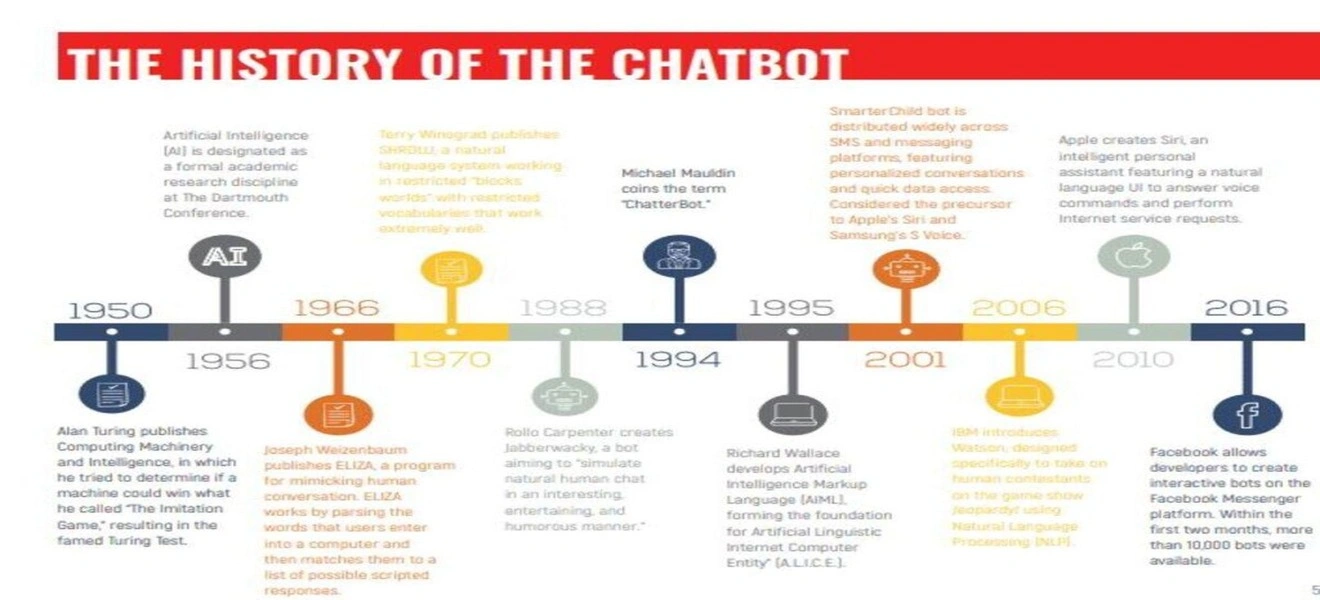Creating a machine that acts and talks like a human has long been the crowning glory of artificial intelligence – chatbots bring us one step closer to machines that talk to us as if they are one of us.
Chatbots were once a cutting-edge application that only the world’s biggest businesses could afford to integrate into their products and services, but today, chatbots are ubiquitous.
It’s tempting to assume that chatbots are a 21st-century development, but actually, they have a long history that dates back almost to the creation of the computer itself.
The Early Origins of AI Chatbots
As of 2021, the year this article was written, the first chatbot – Eliza – is a remarkable 55 years old. Joseph Weizenbaum created Eliza in 1966 and whilst the available programming methods were extremely primitive compared to today, Eliza still proved that computers can at least mimic human text conversation. Eliza relied on processing input statements according to predefined scripts created by Weizenbaum, essentially giving the impression that it can understand text until its limitations are eventually exposed by ongoing conversation.
There were various iterations of the chatbot created throughout the 80s, the next most famous being Parry built in 1972 by Kenneth Colby, a Professor of Psychiatry at Stanford University, USA. Parry tries to emulate a schizophrenic patient and is a stimulus-response chatbot similar to Eliza, but with an additional built-in conversational strategy that improves its functionality.
Parry and Eliza had numerous conversations, the most famous one is available here. Both passed a limited form of the Turing Test for AI, with Parry managing to fool some 52% of psychiatrists that analysed its responses. Of course, people’s sensibilities regarding AI were very much undeveloped at the time, but nevertheless, Eliza and Parry are some of the first computerised devices that were capable of fooling humans into thinking that they were human and were understandably quite shocking or even unbelievable at the time they were developed.
From the late 70s, the evolution of the chatbot increased exponentially. Some notable chatbots that proceeded Eliza and Parry include:
- Jabberwacky, which can be viewed here.
- Dr Sbaitso, which incorporated speech synthesis as well as text
- A.L.I.C.E, a Loeber-prize winning chatbot that utilised NLP to apply heuristic pattern matching to human text inputs.
- SmartChild, a chatbot that lived inside of AIM (AOL), MSN and Yahoo Messenger. It attempted to solve the problem of NLP at scale, allowing the bot to structure conversations into new scripts. Smartchild was the first major chatbot of the internet era.
Into the Modern Era: Machine Learning and NLP
Chatbots today have greatly improved thanks to machine learning (ML) and natural language processing (NLP).

ML enables AI algorithms to learn from vast quantities of linguistic data. NLP annotation and data labelling make conversations easier for AI to consume, leading to increasingly accurate conversational outcomes that are more natural, nuanced and life-like.
Modern chatbots often conjure images of Siri, Alexa, Google Assistant and Cortana, but these are generally viewed as conversational AIs since they recognise speech rather than text inputs (though Alexa officially became a ‘chatbot’ in 2020).
Perhaps this is little more than a moot point, as these AIs use a variety of machine learning approaches to NLP in order to understand both speech and text. Machine learning helps chatbots escape the conundrum of needing to be pre-programmed with conversational strategies.
Some of the heavyweight chatbots of the 21st century include IBM Watson (though technically an AI service and not a chatbot in itself) which famously won a game of the question-answering show Jeopardy! in 2011. In 2016, Facebook allowed developers to deploy interactive chatbots on Messenger – there are now well in excess of 100,000 bots on the platform.
There are some remarkable free chatbots available to use online today, such as:
Chatbots are now ubiquitous, assisting people in everything from booking holidays and flights to learning new languages. Some excellent examples of modern chatbots include MongoDB’s chatbot that helps with lead generation by driving warmer leads to sales calls, to Duolingo, a chatbot-assisted language learning app and Emirates Vacations, which walks users through holiday options.
The Future of Chatbots
Chatbots will eventually handle complex customer requests and booking systems, also taking care of payments and providing personalised options. Chatbots will also extend to internal business processes, assisting employees with onboarding or queries about their tasks.
The ubiquity of chatbots is also set to penetrate science, agriculture and manufacturing, where robot assistants will help researchers conduct experiments and track and organise data.
E-AGRO and Dr. Tania are intelligent chatbots that assist in farming and agriculture, helping farmers make optimal decisions based on input data and identify and treat forms of disease.
Summary: The Evolution of AI Chatbots
The chatbots of the future are likely to further bridge the gap between robotic and human verbal and textual conversation, becoming increasingly emotionally sensitive and autonomous in the process.
ML and NLP equip chatbot AIs with the tools they need to work with vast volumes of linguistic information with each new conversation or experience being learnt, remembered and implemented in the future.






